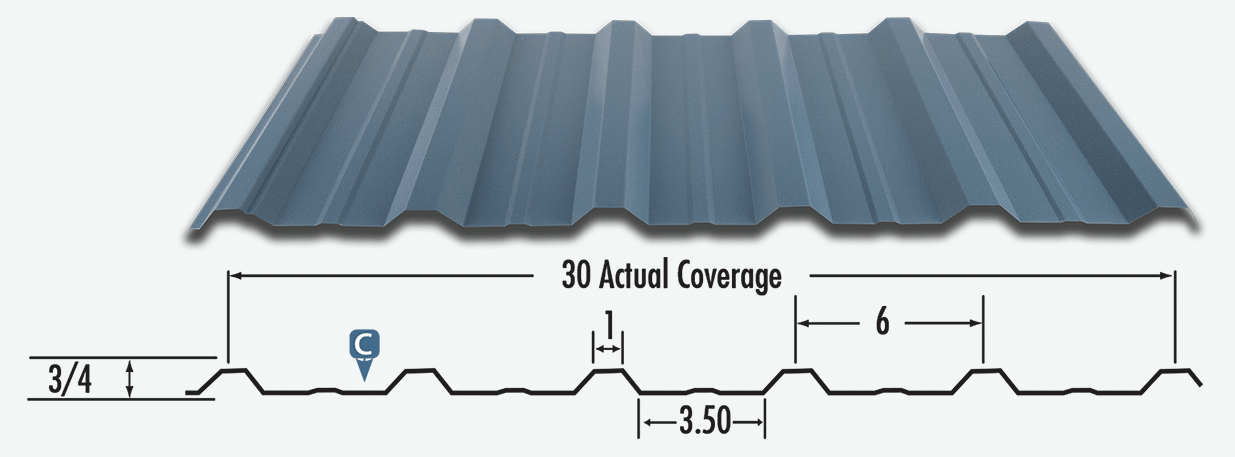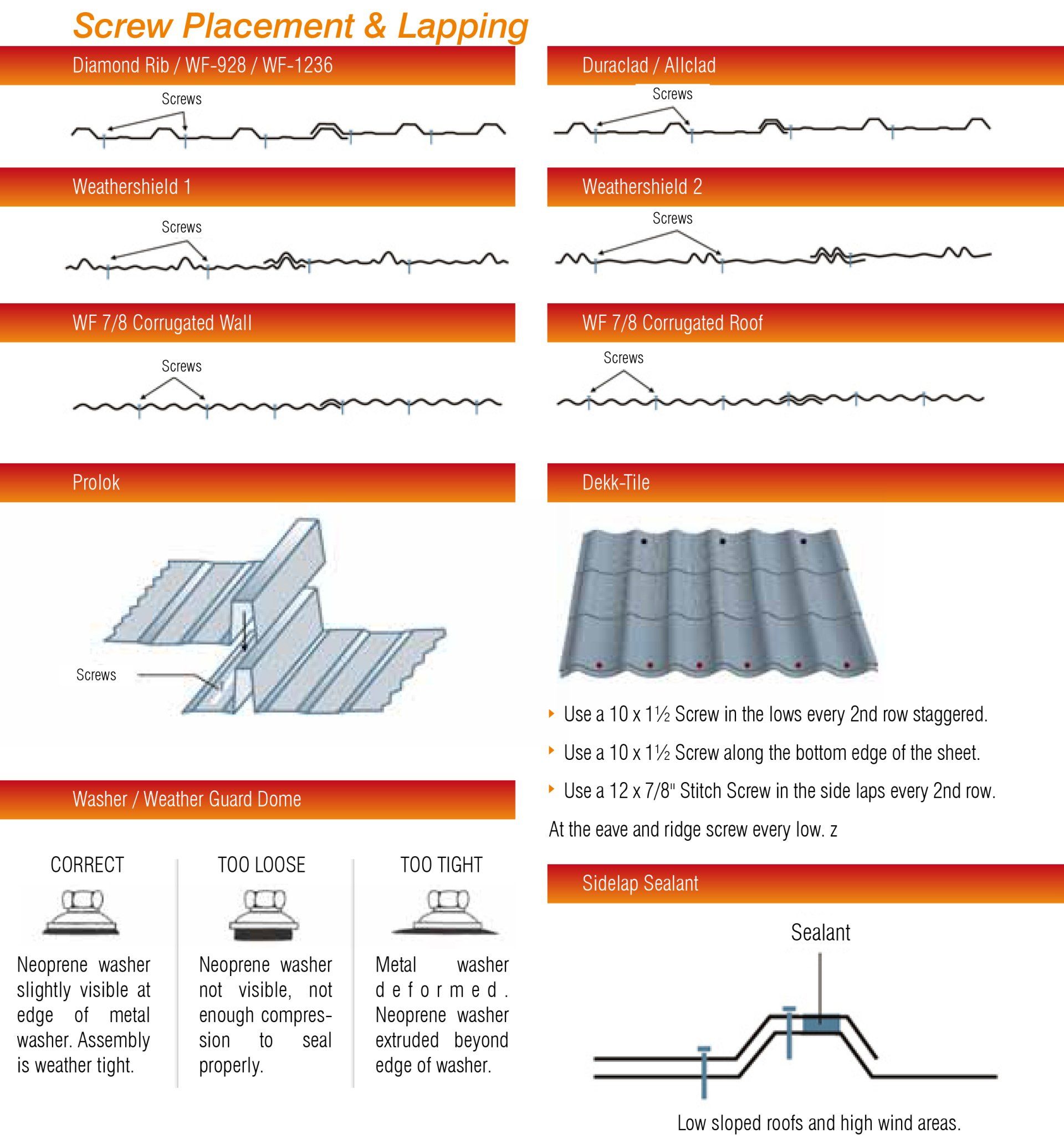Diamond Rib Metal Panel
Diamond Rib is a multipurpose profile for walls or roofs.
With ¾” high trapezoid rib design and 6” rib spacing, Diamond Rib is a strong, attractive profile that fits in any application.
Brochures and Installation Guides
Screw Down Panel Installation
Heavy Snow Area
* 26 Ga Metal Panel or heavier
* Solid Sheeting
* Min 15 lbs felt/ Nova Seal Recommended.
* Keep plumbing stacks and chimneys at the peak if possible
* Ridge and Eave Closures
* Valley and Hip Closures
* Pipe Flashing and Retro fit for stacks
* Profile Roof Vent
* Sealer tape on end lapped panels
Low Slope Roofing 2/12 to 3 /12
* Closures at Ridge
* Closures at Eave
* Solid sheeting recommended
* Sealer Tape on side laps
* Stitch Screws on side laps 16” OC
* Underlay Minimum Nova Seal
* Pipe Flashing and Retro Fit for stacks.
* Profile Roof Vent
* Sealer tape on end lapped panels
* Dekk-tile panel must be installed on a 3/12 pitch or higher
Steep Slope Roofing 4/12 pitch and Higher
* 29 / 26 / 24 Ga Metal Panel
* Strapping 2’ OC / 16” recommended
* Minimum 15 lbs Felt
* Profile Roof Vent
* Pipe Flashing and Retro fit for stacks
* Horizontal screw lines every 2’ on solid sheeting
* Horizontal screw lines every 2nd row for strapping on 16” center
* Ridge and Eave Closures
* Valley and Hip closures
* Sealer tape on end lapped panels
Metal roofing can be installed over solid wooden deck, minimum 7/16”. Use solid sheeting with a heavy snow load or a low slope roof (2/12). Also, the use of 26 gauge material is recommended. In some areas 2X4 strapping on 16” centers will be adequate. For ridge vents make sure you leave a 1 ½” on each side. Check building codes in your area for attic ventilation.
Minimum 15 lbs felt must be used under the metal panel. On strapping apply the underlayment ridge to eave. Make sure it is stapled on tight, no sagging. Overlap the underlayment 3-6”. The underlayment is not for water proofing, it is for condensation and to reduce sound. On an insulated building the noise will not be a factor.
On solid sheeting, screw down panels every 24” from eave to ridge. Place the screws in the flat pan beside the major rib. In heavy wind areas you may need to put screws on both sides of a major rib at the ridge and eave. On low slopes use sealer tape on the side laps. Also, use stitch screws on the side lap every 16” as this compresses the lap into the sealer tape.
On strapping spaced every 16”, screw every second strapping unless you are in a heavy wind area; then screw every strapping.
When screwing flashings to roof panels (e.g. ridge to Duraclad) we recommend using stitch screws. Stitch screws have a self drilling head. They are made to hold two pieces of metal together. Screw through the flashing into the top of the major rib. All flashings need to be lapped minimum 4” and it is recommended to use a good caulking between the laps of the flashings.
At the ridge large closures are placed on top of the panel. They have glue on one side to hold to the sheet. Place the ridge cap over the closure and screw through closures into the major rib. At the eave use small closures to stop water from wicking up under the roof panel.
At the eave use an Eave Flashing. Lap 4” and use roofing nails spaced 16”.
At the gable you will need a Gable trim. Install from the eave up to the ridge with a 4” lap. Fasten every 2’ to the fascia and the roof panel with screws. Make sure to use caulking between the flashing and the roof panel. (Sealer Tape) The ridge cap goes over the gable trim.
The valleys should be lapped a minimum of 6” with caulking between the end laps. Minimum code for valleys is 24” wide. You must use a W valley if you have a pitch change on one side of the valley. Cut the sheets back from the center of the valley 4-6” and in heavy snow areas 6-10” with a 36” valley. Universal Closures or a double row of sealer tape should be placed under the roof panel and on the valley approximately 2-4” up from where the panel will sit.
Hip ridge uses a universal closure on top of the panels. Screw the Hip Cap over the ridge into the rib of the roof panel.
End wall Flashing will need large closures on top of the roof panel.
Use Roof Transition flashing where one roof pitch meets another. You will need closures at the top and bottom of each sheet.
Skylight Flashing. The size of the flashing is determined by the height of the curb (usually a 2x6 wood curb). At the ridge side of the Skylight use a Pan Flashing which goes up to the top of the curb: it goes up the roof between 12” and 18”. The roof panels here are kept back 4-6” from the curb. This allows water to travel around the top and spill onto to the roof panels at the side of the Skylite. If the rib of the panel is within 4” of the skylight curb screw the sidewall to the top of the rib in the panel. If not, fold the panel up the skylight curb and screw the sidewall into the curb. Use small closures under these sheets. On the other 3 sides use a Sidewall Flashing. Use large closures at the bottom of the Skylite.
Chimney Flashing uses the same pieces as the Skylite. The only difference is the Pan Flashing and Endwall are broken to the pitch of the roof.
Install the prow gable flashing before any panels. Screw the prow face to the fascia every 2’. Nail flat side of the prow flashing with roofing nails every 2’. Apply a double row of sealer tape on the flat of the prow parallel to the face of the flashing, about 6” from the face. Install panels 2” away from the upturn of the prow flashing.
When ordering your roof we need the pitch of the roof to brake the angles of your flashing. If we are not told the pitch we brake the flashings at a 4/12 pitch. Also specify color and gauge of metal.
WCB guidelines should always be followed when installing metal roofing.
Care & Maintenance
Pre finished sheet steel building products, such as wall and roof cladding, liner sheet, flashing, and associated items, have experienced an enviable growth record during the past twenty years or so. Coil coated pre finished sheet steel in a variety of colours and paint systems has greatly enhanced the appearance of thousands of industrial, commercial, institutional, recreational, residential and farm buildings, providing an economical, durable and attractive alternative to traditional materials. As with all materials, a little care and maintenance pays off handsomely in terms of longevity and repair costs. The recommendations which follow have been learned at first hand and represent the collective industry experience with thin- film paint systems applied to metallic coated sheet steel by the coil coating process. In this publication the term “thin-film paint system” refers to a modified silicone polyester or a fluorocarbon type having a coating thickness about 25um.
When the guidelines listed below have been observed, thin-film paint systems have been used successfully for all types of environments other than severe industrial atmospheres which require special consideration. The guidelines are not intended for barrier coatings, laminates, and new formulations which have different characteristics than the thin-film paint systems on which these guidelines are predicated.



